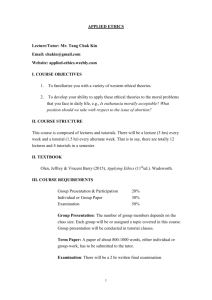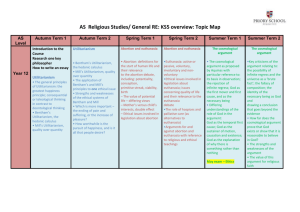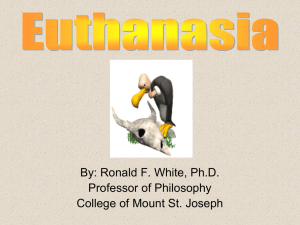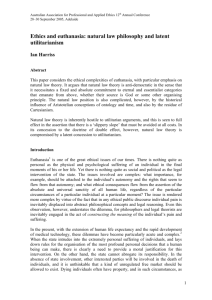File - Applied Ethics
advertisement
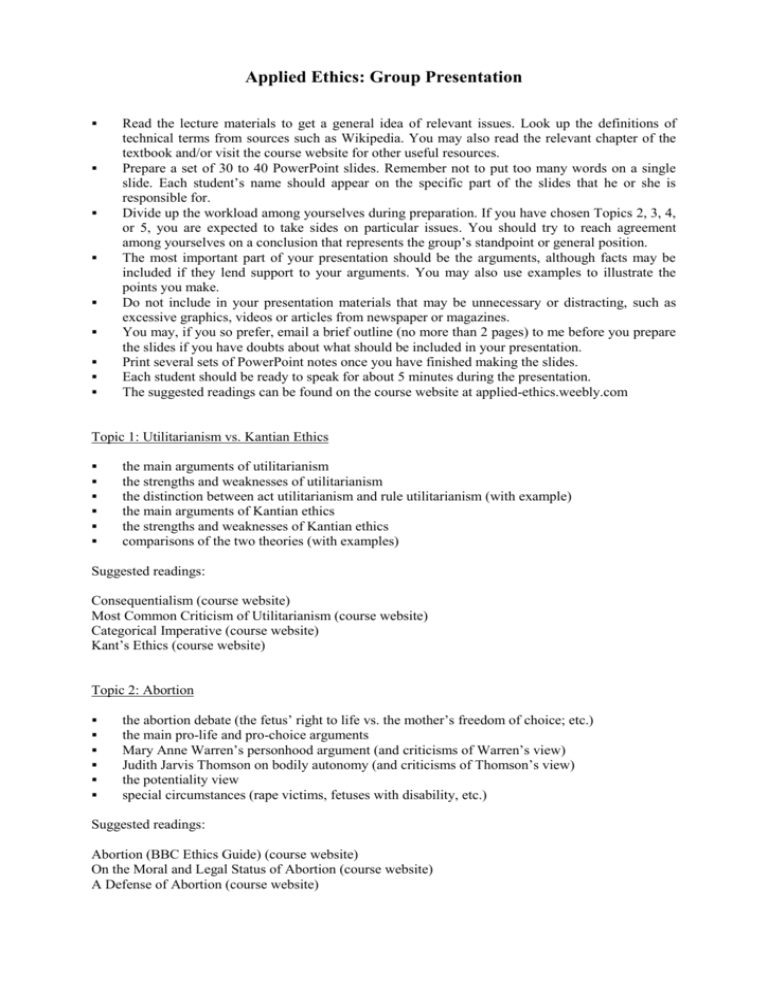
Applied Ethics: Group Presentation Read the lecture materials to get a general idea of relevant issues. Look up the definitions of technical terms from sources such as Wikipedia. You may also read the relevant chapter of the textbook and/or visit the course website for other useful resources. Prepare a set of 30 to 40 PowerPoint slides. Remember not to put too many words on a single slide. Each student’s name should appear on the specific part of the slides that he or she is responsible for. Divide up the workload among yourselves during preparation. If you have chosen Topics 2, 3, 4, or 5, you are expected to take sides on particular issues. You should try to reach agreement among yourselves on a conclusion that represents the group’s standpoint or general position. The most important part of your presentation should be the arguments, although facts may be included if they lend support to your arguments. You may also use examples to illustrate the points you make. Do not include in your presentation materials that may be unnecessary or distracting, such as excessive graphics, videos or articles from newspaper or magazines. You may, if you so prefer, email a brief outline (no more than 2 pages) to me before you prepare the slides if you have doubts about what should be included in your presentation. Print several sets of PowerPoint notes once you have finished making the slides. Each student should be ready to speak for about 5 minutes during the presentation. The suggested readings can be found on the course website at applied-ethics.weebly.com Topic 1: Utilitarianism vs. Kantian Ethics the main arguments of utilitarianism the strengths and weaknesses of utilitarianism the distinction between act utilitarianism and rule utilitarianism (with example) the main arguments of Kantian ethics the strengths and weaknesses of Kantian ethics comparisons of the two theories (with examples) Suggested readings: Consequentialism (course website) Most Common Criticism of Utilitarianism (course website) Categorical Imperative (course website) Kant’s Ethics (course website) Topic 2: Abortion the abortion debate (the fetus’ right to life vs. the mother’s freedom of choice; etc.) the main pro-life and pro-choice arguments Mary Anne Warren’s personhood argument (and criticisms of Warren’s view) Judith Jarvis Thomson on bodily autonomy (and criticisms of Thomson’s view) the potentiality view special circumstances (rape victims, fetuses with disability, etc.) Suggested readings: Abortion (BBC Ethics Guide) (course website) On the Moral and Legal Status of Abortion (course website) A Defense of Abortion (course website) Topic 3: Racism, Sexism, and Affirmative Action racism and sexism as a social problem (definitions, significance, and examples) racism and sexism as a moral problem (justice and equality) comparisons between affirmative action and equal opportunity policy arguments for affirmative action arguments against affirmative action conclusion: whether or not affirmative action is the best solution to problem of discrimination Suggested readings: Racism and Sexism (course website) Affirmative Action is not Reverse Discrimination (course website) The Case Against Affirmative Action (course website) Topic 4: Animal Rights speciesism and the arguments for and against it Kant’s anthropocentric view of animals (and criticisms of Kant) Peter Singer on animal welfare (and criticisms of Singer) Tom Regan on animal rights (and criticisms of Regan) whether animals should have rights; and if so, what rights do animals have comments on current practices of factory farming and animal experimentation Suggested readings: Animal Ethics (BBC Ethics Guide) (course website) Speciesism and the Idea of Equality (course website) All Animals are Equal (course website) The Case for Animal Rights (course website) Topic 5: Euthanasia the euthanasia debate and definitions of different types of euthanasia the right to die and other arguments for voluntary euthanasia arguments against voluntary euthanasia James Rachels on active and passive euthanasia (and criticisms of Rachels) involuntary euthanasia, non-voluntary euthanasia and physician-assisted suicide whether or not any form(s) of euthanasia should be legalized and why (not) Suggested readings: Euthanasia and Physician Assisted Suicide (BBC Ethics Guide) (course website) Voluntary Active Euthanasia (course website) Active and Passive Euthanasia (course website)
